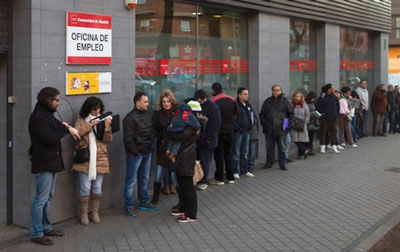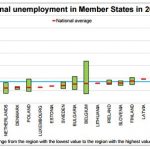Eurozone unemployment rate falls to 10.3%

Unemployment in the eurozone fell for a third consecutive month in January, dropping to its lowest rate since August 2011.
Eurostat, the EU’s statistical agency, said the jobless rate in the 19-country eurozone declined to 10.3% in January from 10.4% in December.
The number of people unemployed in the eurozone fell by 105,000 to 16.65 million.
The eurozone’s jobless rate hit a high of 12.1% during the first half of 2013.
In the 28 member European Union the unemployment rate fell to 8.9%. That was down from 9% in December and the lowest rate recorded since May 2009.
The lowest unemployment rate in the eurozone was in Germany at 4.3%, while the highest rates were in Spain, at 20.5%, and Greece, at 24.6%.
Weaker demand
According to Markit’s survey of purchasing managers for eurozone manufacturers on Tuesday activity expanded at its weakest pace for a year last month as deep price cuts failed to boost slowing order growth.
Markit’s manufacturing PMI for the eurozone dropped to 51.2 from January’s 52.3.
Chris Williamson, Markit’s chief economist said: “Concerns are growing that the region is facing yet another year of sluggish growth in 2016, or even another downturn. Lacklustre domestic demand is being compounded by a worsening global picture.”
This could slow the decline in unemployment as businesses become more cautious about taking on new staff.
Constant encouragement
On Monday, separate figures showed that the eurozone fell back into deflation in February, driven by lower energy costs, particularly crude oil.
The latest inflation figures from Eurostat estimated that consumer prices across the region were 0.2% lower last month than a year earlier.
The return of deflation is seen as increasing the likelihood that the European Central Bank will announce more stimulus measures at its meeting next week on 10 March.
This will probably mean more quantitative easing – buying financial assets with newly created money.
Another expected measure is a further cut to its bank deposit rate, which is already in negative territory.
This means commercial banks are penalised for depositing their reserves with the central bank in the hope they will lend their cash to the private sector.
The Organisation for Economic Cooperation and Development has joined the International Monetary Fund and the World Bank in cutting its growth forecasts for 2016.
The Group of 20 (G20) finance ministers and central bankers agreed on Saturday to use “all policy tools, monetary, fiscal and structural – individually and collectively” to renew growth.
Source: BBC





























